 GCC Library Archives GCC Library Archives
|
Planning & Construction |
Early Years 1965-1970 |
The Stellar 1970s |
The Electric 1980s |
The Millennial 1990s |
21st Century 2000s |
GCC at 50 2010s |
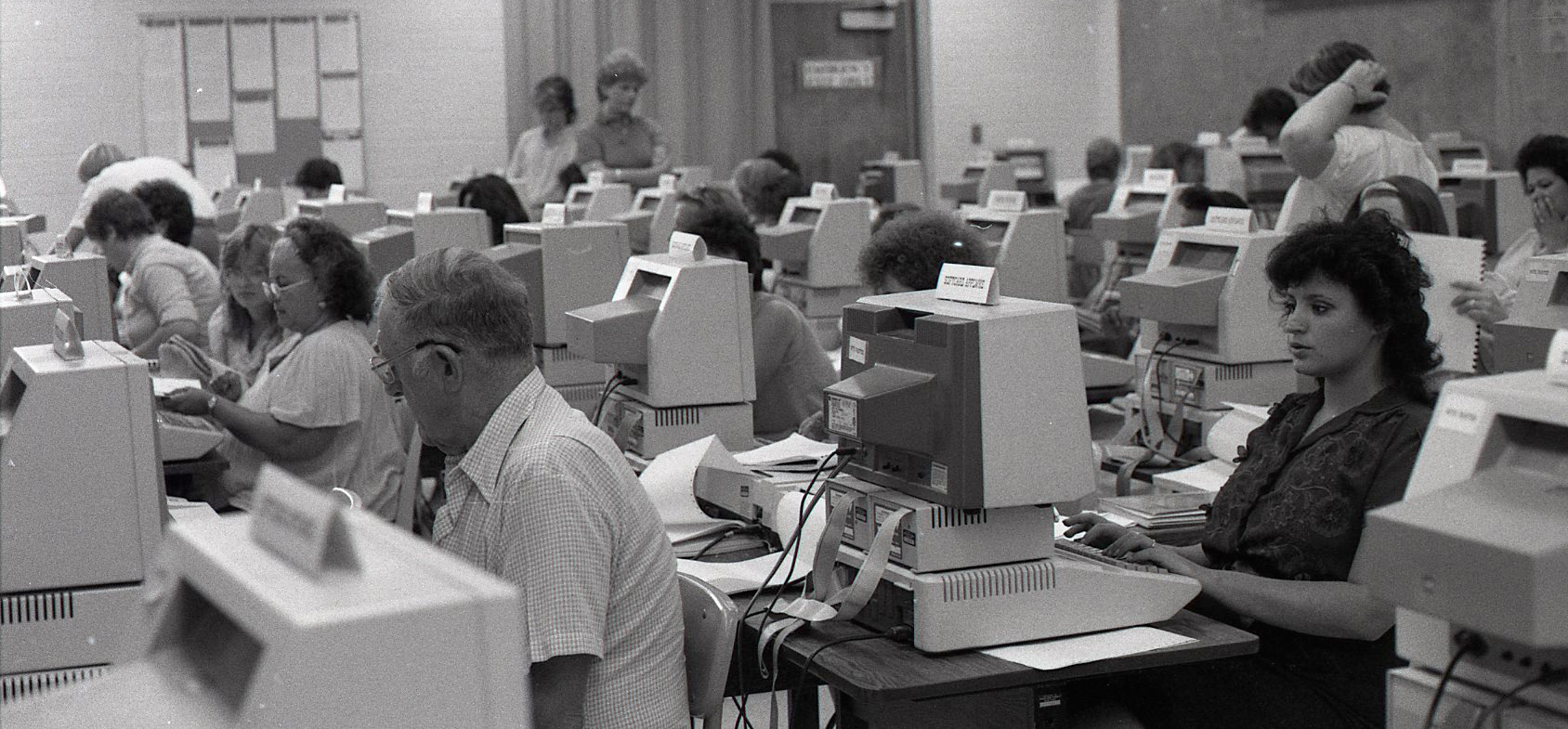
The Electric 1980s
Welcome to the New Age

In the 1980s, the GCC campus entered the computer age. This radical shift had a transformative effect both for the campus and GCC students. As computer courses and programs flourished, early computers invaded the campus and classroom. In the Student Lounge, Gauchos entertained themselves with video games such as Pac Man, Defender, and Q*bert. Still, this college transformation was just one of many milestones accomplished during the decade as Glendale strode forward despite budget cuts to find success in both academics and sport. All this and more can be found below through the images, stories, and historical documents of GCC's Electric 1980s.
The Dawn of the Computer Era
During the 1980s, the computer age swept through the campus. Seemingly overnight, computers were everywhere fundamentally altering both college and the classroom. The eighties generation of college students were the first to experience the full impact of this radical educational transformation. Below are photographs of both the time and technology.
 |
The Computer ClassroomWith the arrival of computers came the advent of the computer classroom. This photograph showcases a computer classroom of the era where students at computers listen to a professor lecturing at the front of the room. |
 |
Disk CheckoutBefore the cloud, before flash drives, DVDs, and CDs. Even before the 3.5in disks (ie save icon), there was the 5.25-inCH floppy disk. These disks were vital to both booting computers and running programs. In this 1984 photograph, students are gathered at a disk checkout station eager to check out disks to run early computer applications. |
 |
Early GCC Computer LabThis photograph shows an Eighties era computer lab with numerous GCC students busy at work. |
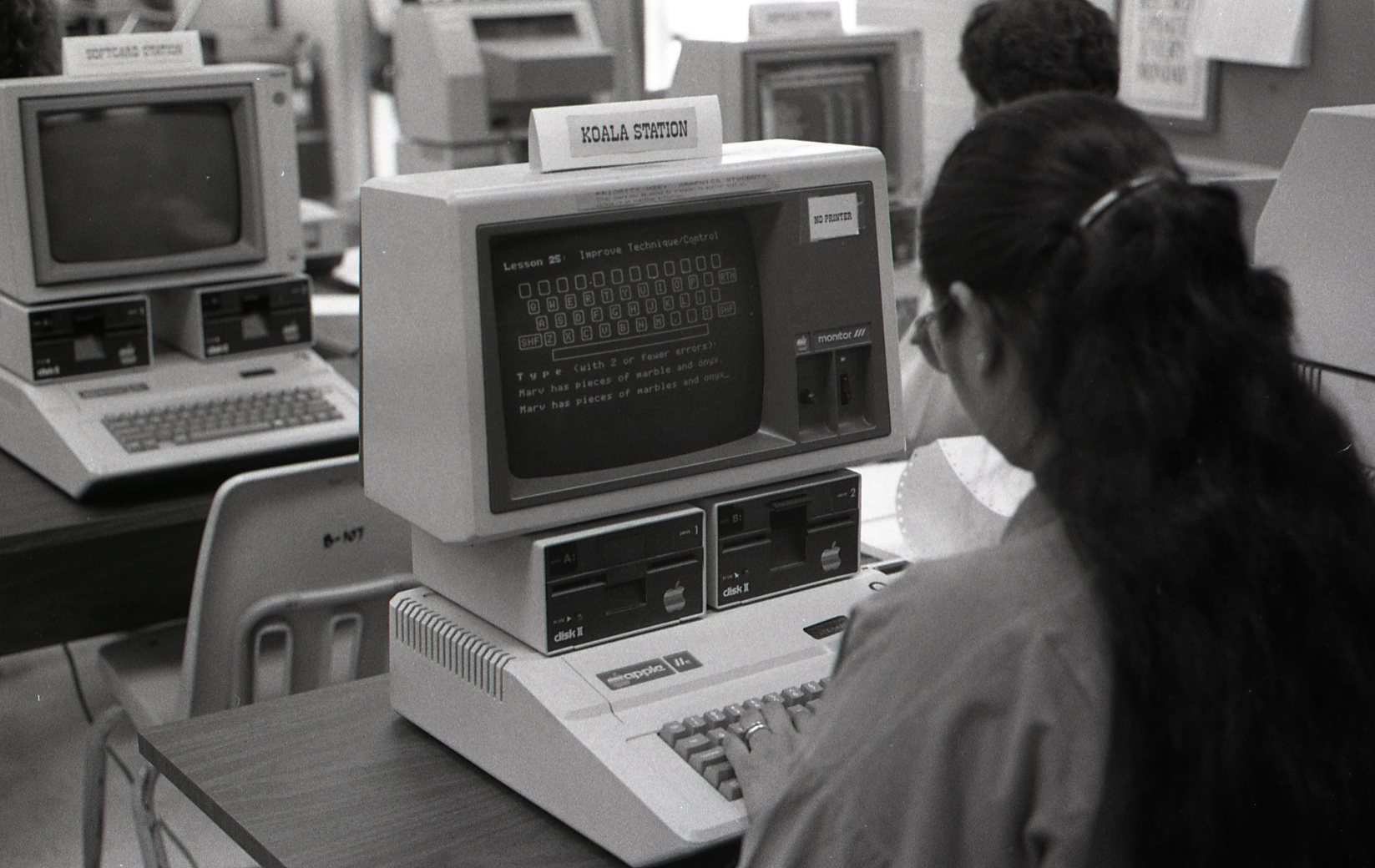 |
Student at an Early ComputerPictured here is a student using an early computer to improve her typing. Computers have come a long way since this time period. In the Eighties these systems lacked both the World Wide Web and many of the applications we currently take for granted. |
 |
1984 Color Photograph of a Student at the ComputerThis photo shows a student working on an early computer. Note that the computer screen is entirely black with green colored text. This was typical of most early computers that lacked significant graphic and display capabilities. |
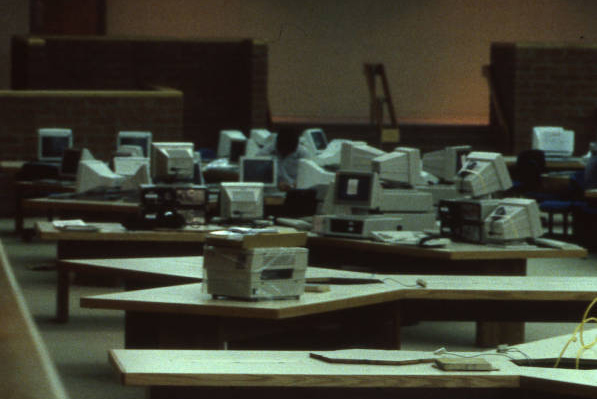 |
High Tech PreparationIn order to accommodate the technological and student demand, GCC needed a computer lab. With this in mind, GCC built the High Tech Center that stands today. This early photo shows the High Tech Center just as the computers had arrived and were being readied for the GCC student use. |
 |
Completed High Tech CenterHere is a sweeping shot of the early High Tech Center. The High Tech Center has supported the technological needs of students from its opening in 1987 until today. |
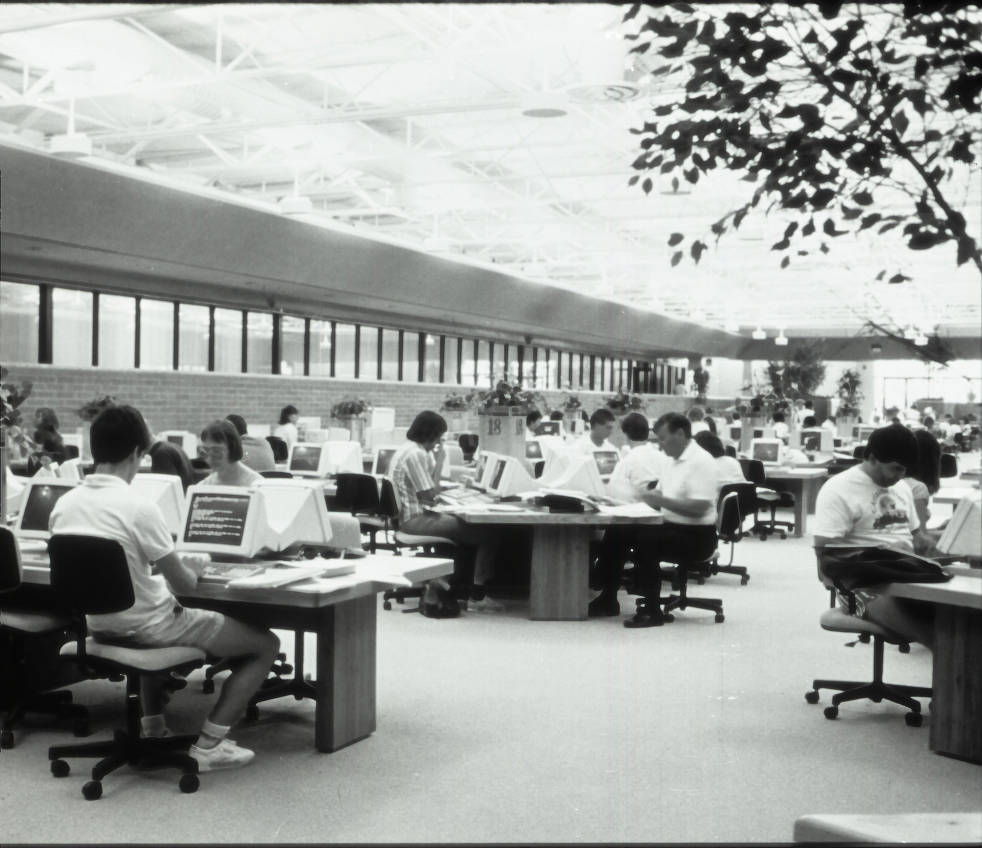 |
View From Within the High Tech CenterThis open lab area in the High Tech Center was affectionately referred to as "The Pit". |
The GCC Library of 1985
In the movie "Back to the Future", main character Marty McFly travels from his present 1985 to the futuristic 2015. We wondered how much has changed at the GCC Library in the thirty years since 1985. With this in mind, we present this collection of GCC Library photos from 1985. See any differences?
 |
Entering the LibraryA student smiles as she enters the library through large wooden doors. This was the main entrance to the GCC Library. Embedded inside the door are a variety of colors of stained glass. These same colors were used in the metal and glass shaded entranceways of the current GCC Library. |
 |
Studying at the GCC LibraryThis photo depicts students studying in the library. Note the number of books each student has stacked in front of them. Current library researchers can find a great deal of information through online library databases in addition to physical print books. However, during this era, print was by far the predominant means for transmitting thoughts and ideas. |
 |
Students Work at Typewriters in the GCC LibrarySimilar to today, many students came to the GCC Library to type a paper. However, during this era, students used unforgiving typewriters as opposed to today's computers equipped with Microsoft Word. Unfortunately, typewriters did not come equipped with a spell check feature. Typing mistakes forced a person to either start over or employ liquid paper to hide the errors. |
 |
Studying at the GCC Library - The Reference DeskStudents seek answers to research questions at the GCC Library Reference Desk. In the background, the GCC Library card catalog can be seen. Before computers, students and faculty located books by perusing wooden drawers filled with cards arranged alphabetically by author, title, or subject. |
 |
GCC Library's Online Public Access Catalog (OPAC)Before the widespread advent of the World Wide Web and full-text searching, students used this basic system to search for books and other materials. This is the initial search page of the OPAC that lists the command prompts required to indicate the type of search to be performed. For instance, for subject searching "s=" was entered followed by the subject heading. For title searches, "t=" was entered followed by the desired title. For author searches, "a=" followed by the author's last and first names was required. These first generation OPACs, as they are now referred, were designed to mirror the library's card catalog system which also divided information into the same categories. |
 |
Library MediaThe media area contained a variety of audiovisual materials including tapes, film, cassettes, and a variety of other formats. In the photo, a librarian is operating a large film projector while another student listens to headphones and views the film. |
 |
Researching at the Library - IndexesA student takes notes from a published magazine index, possibly The Reader's Guide to Periodical Literature. Modern students often find magazine and journal articles for research assignments using library databases or search engines. During this era, these one-stop search systems did not exist. Students used published indexes that focused on general topics or specific fields. After they located a relevant article in an index, they noted the magazine or journal name, its date, and the page numbers. Students either located the article in bound volumes of the magazine or journal or used microfilm or microfiche to view a photo of the article. |
 |
Researching at the Library - Microfiche ReadersA student takes notes from a national newspaper index. This index was likely stored on technology known as microfiche. During this era, students would often view indexes and items stored on microfiche, which essentially are sheets of film that students could enlarge and display on a microfiche reader. |
 |
Students ReadingStudents read in the Leisure Reading section of the Eighties era library. |
Eighties Photo Collections
Fortunately, the 1980s were a well photographed decade. Below you will find a number of photos taken during this era.
  |
Community DayMultiple photos taken during the Glendale Community College Community Day held on November 21st, 1981 (from 9am until 12pm). The event was hosted by Channel 12 TV personality Dewey Hopper who, handed out two $50 college scholarships donated by the Day and Evening Student Governments. Additional door prizes featured at the event included displays, demonstrations, tours, entertainment, and refreshments. Also at the event was artwork by artist Shirley Hetzger, music by the college Jazz Ensemble, one-act plays from the acting class, songs by the College Gospel Ensemble, and free coffee, doughnuts, and Dr. Pepper. 1 |
 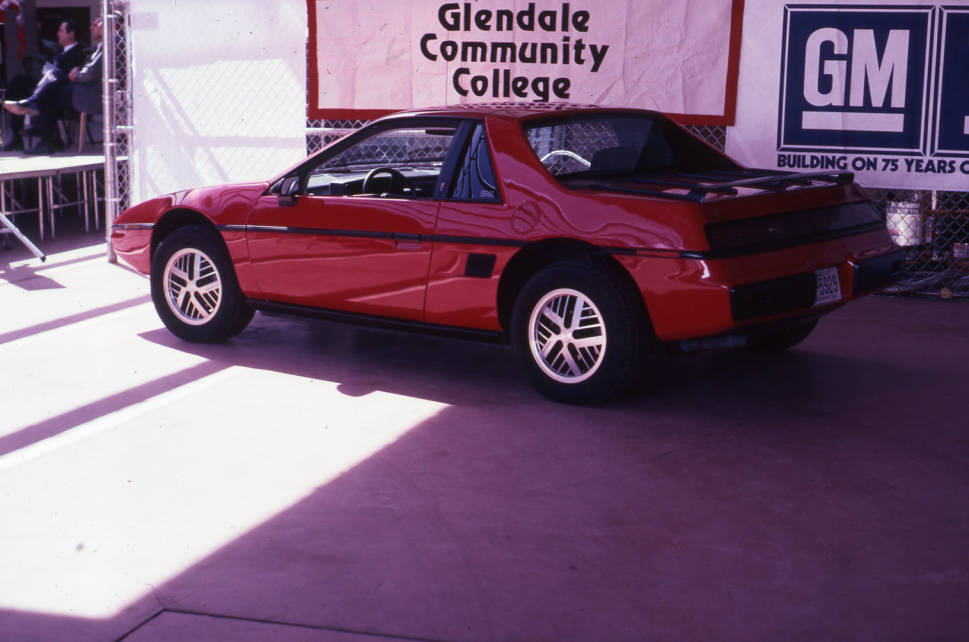 |
Dedication Ceremony for the GCC Automotive Technology ComplexMany of the photographs in this collection were taken at the dedication ceremony for the GCC Automotive Technology Complex. The $250,000 Automotive Technology Complex featured 25,000 square feet of open-air bays, classrooms, and a machine shop. This building represents the new Automotive Service Educational Program (ASEP), which began alongside the building's dedication. This program was designed in conjunction with General Motors who also donated a '84 Pontiac Fiero for the event. This program allowed students to obtain an associate of arts degree in applied science for automotive technology and be placed with GM dealers throughout the Southwest. It marked a major milestone for the college and the ASEP program continues to this day. In attendance during the ceremony was Glendale Community College President Dr. John R. Waltrip, Phillip Randolph (Automotive Technology Chairperson, Dean of Occupational Education, and Future GCC President), Jake Kane (General Motors Manager of Training and Development in Detroit), and numerous notable people.2 |
 |
Veterans Service CenterThis photo was taken in the Veterans Service Center at the college. GCC has always supported a large amount of veteran students. |
 |
Financial AidsThis photo of the Financial Aids office was taken around 1985. The Financial Aid Office has long helped students pay for college by assisting them to find grants, scholarships, and loans. |
 |
1980s RegistrationThis collection of photos depicts the registration process for students in 1985. During this era, the Enrollment Center was not yet in place nor did students have ready access to computers and the internet. Therefore, much of this work took place in the current Student Union and was completed by hand. |
 |
Eighties Campus CandidsJust like the students of today, the students of the 1980s gathered on campus to enjoy camaraderie and community. These candid shots of students during the eighties depict campus life outside of the classroom where friendships were formed and lasting bonds were made. |
GCC In the News
In the 1980s, student reporters covered a wide range of stories. They covered campus issues such as budget cuts, parking, martial arts programs, fun at the state fair, a controversial capstone course, and the safety of GCC fallout shelters3. They also lent their voices to broader national issues such as Apartheid, AIDS, Reaganomics, the War on Drugs, and Hulkamania. For all these stories and more, take a look at the College Voice's issues of the era.

- College Voice Vol. 16 (formerly "El Tiempo Pasando") [September 11, 1980 - April 30, 1981]
- College Voice Vol. 17 [September 10, 1981 - December 10, 1981]
- College Voice Vol. 18 [January 28, 1982 - May 06, 1982]
- College Voice Vol. 19 [September 09, 1982 - May 05, 1983]
- The Voice Vol. 19 (formerly "College Voice") [September 01, 1983 - May 10, 1984]
- The Voice, Special Preview Issue, 1983-1984, Vol I
- The Voice Vol. 20 [August 30, 1984 - May 02, 1985]
- The Voice, Special Preview Issue 1984-1985, Vol II
- The Voice Vol. 21 [August 26, 1985 - May 05, 1986]
- The Voice Vol. 22 [August 25, 1986 - May 04, 1987]
- The Voice, Special Preview Edition, Fall 1986 [Fall, 1986, Special Preview Edition]
- The Voice Vol. 23 [August 24, 1987 - May 02, 1988]
- The Voice, Special Preview Edition, Fall 1987 - Spring 1988
- The Voice Vol. 24 [August 29, 1988 - May 19, 1989. Also contains the Special AIDS Supplement issue dated May 08, 1989]
- The Voice Vol. 25 [August 28, 1989 - May 17, 1990]
The Traveler

During the decade, The Traveler won several Columbia Scholastic Press' Medalists Awards, the highest honor given by the association.4 Throughout the decade, GCC students continued this rich tradition of literary and artistic excellence. Below are links to the Eighties issues of this premier and award-winning student literary magazine.
Student Bulletins
Today colleges often send important messages to students through large email blasts or social media. However, even during the Eighties, the college had important messages it needed to relay to its students. To do so, the college would send out student bulletins to inform students of the different activities and events happening during that time. These student bulletins began during the inception of the college and lasted until 1985. Below are the final issues of the GCC Student Bulletin that were printed and distributed across the campus.
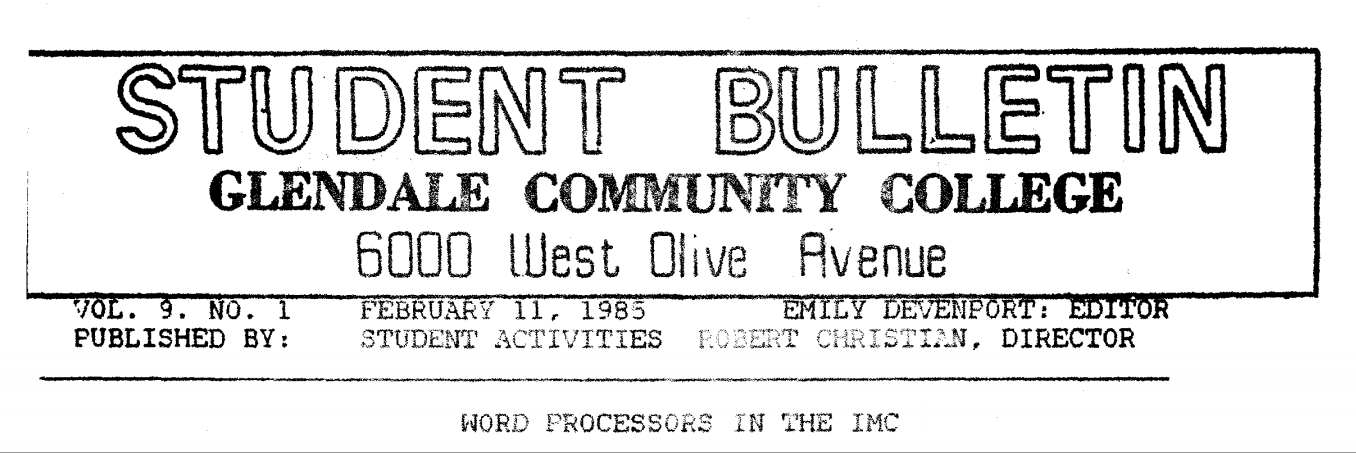
- Student Bulletin, unnumbered issues from August 25, 1980 - April 25, 1981
- Student Services Courier (formerly "Student Bulletin"), 1981-82, Volume 01, Numbers 01-12; Volume 02, Numbers 01-10. November 04, 1981 - April 27, 1982
- Student Services Courier, 1982-83. Contains incomplete volumes from Volume 01 to Volume 05.
- Student Services Courier, 1983-84, Volume 06, Numbers 01-16; Volume 07, Numbers 01-15. August 15, 1983 - May 02, 1984.
- Student Services Courier, 1984-85, Volume 08, Numbers 01-13; Volume 09, Number 01.
Course Catalogs

Curious as to what GCC students were studying in the Eighties? Look no further than the course catalogs from this era. Here you can see the different classes and programs offered during the decade.
- GCC Course Catalog, 1979-1980 and 1980-1981
- GCC Course Catalog, 1981-1982
- GCC Course Catalog, 1982-1983
- GCC Course Catalog, 1983-1984
- GCC Course Catalog, 1984-1985
- GCC Course Catalog, 1985-1986
- GCC Course Catalog, 1986-1987
- GCC Course Catalog, 1987-1988
- GCC Course Catalog, 1988-1989
- GCC Course Catalog, 1989-1990
Graduations
Below are the commencement programs for 1980s, and within them are the names of both faculty and students of the graduating year. From 1985 onward, video recordings were also made of each GCC graduation. Therefore, you may also view video of the graduations from 1985 to 1990 using the video links below.

- 1981: Commencement Program
- 1982: Commencement Program
- 1983: Commencement Program
- 1984: Commencement Program
- 1985: Commencement Program | Video
- 1986: Commencement Program | Video
- 1987: Commencement Program | Video
- 1988: Commencement Program | Video
- 1989: Commencement Program | Video
- 1990: Commencement Program | Video
Next Chapter: The Millennial 1990s
1“Glendale Community College Student Services Courier (formerly "Student Bulletin"), 1981-82, Volume 01, Numbers 01-12; Volume 02, Numbers 01-10. November 04, 1981 - April 27, 1982
2Liljegren, Lynn and Eileen Cohn. "'84 Fiero Revs Up Auto Complex". The Voice, Special Preview Issue 1984-1985, Vol II .
3Anderson, Debra. "Campus Fallout Shelters Meet Minimum Standards". The Voice, February 26, 1981. .
4Bennington, Rene. "Campus Literary Magazine Seeks New Material". The Voice, September 8, 1986. .

